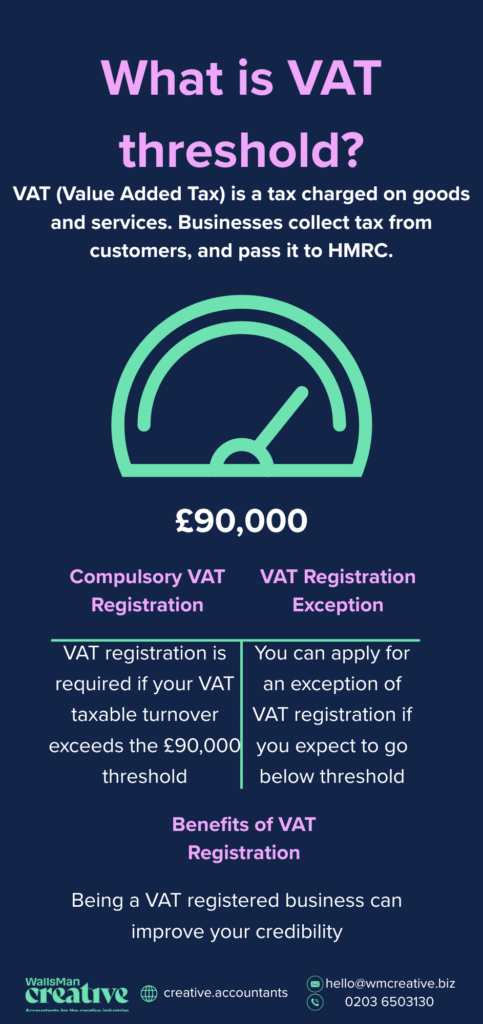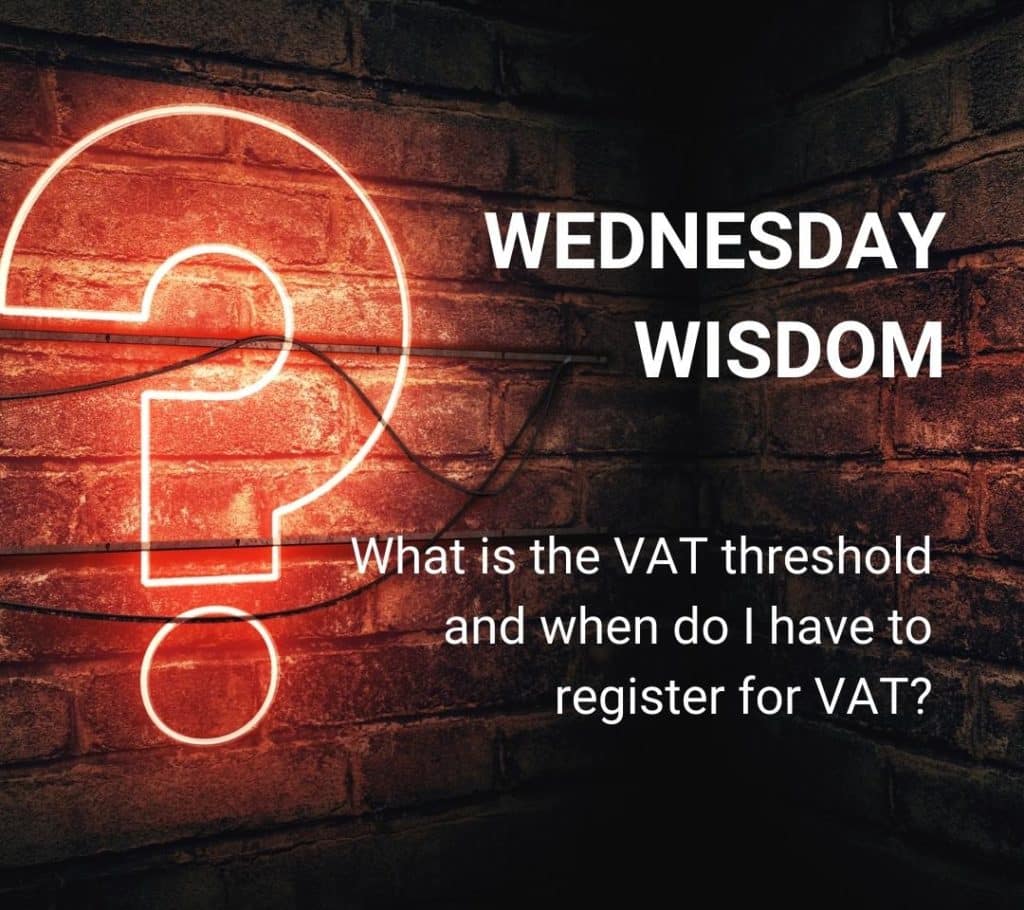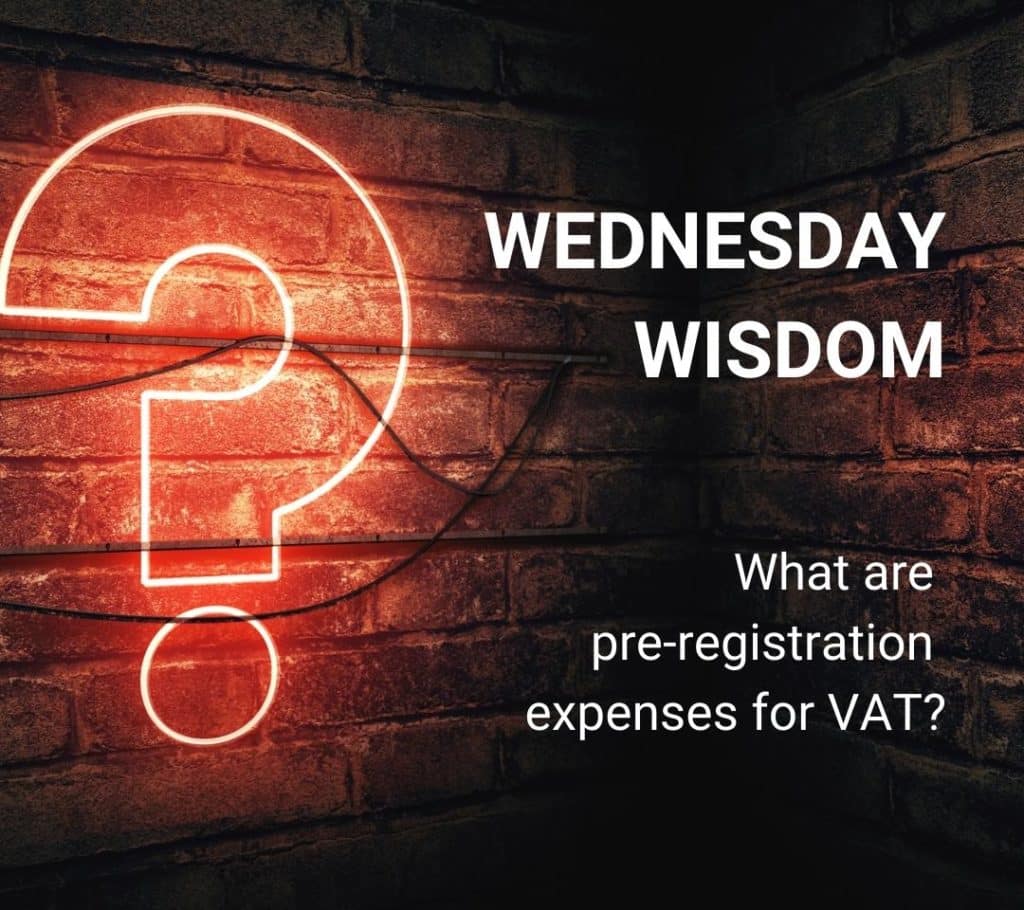Some of the most often asked questions around Value Added Tax are:
- What is the VAT threshold?
- When do you need to register for VAT?
Here we explain the thresholds which would require your business to legally register for VAT.
Creative Takeaways
- VAT (Value Added Tax) is a 20% tax applied to most goods and services in the UK.
- The VAT threshold for compulsory registration is £90,000 in any 12-month rolling period of taxable turnover.
- You must register for VAT if your turnover exceeds the threshold or is expected to do so within 30 days.
- You can request a VAT registration exception if the threshold was temporarily exceeded and you can show that your turnover will soon fall below the limit.
- VAT deregistration is allowed if your taxable turnover drops below £88,000, or if you stop trading or sell only VAT-exempt goods/services.
Table of contents
1. What is VAT?
VAT, or Value Added Tax, is a tax charged on most goods and services in the UK.
When you buy something, like a new laptop, a software subscription, or even a cup of coffee, a portion of that price is VAT. Businesses collect this tax from customers and pass it on to HMRC.
The standard VAT rate is 20%, which applies to most products and services.
Beside the standard VAT rate, there are different categories, but the most common are:
- Reduced rate (5%): some goods and services, e.g. children’s car seats or home energy have a reduced rate of 5%.
- Zero-rated (0%): most food and children’s clothing and books fall into this category. 0% means they don’t have VAT.
2. What is the VAT threshold for registration?
If you’re a business, you only need to worry about VAT when your taxable turnover exceeds £90,000 in a 12-month period.
At that point, you need to register for VAT as it becomes mandatory, and you’ll need to start charging VAT on your sales.
How VAT rates impact your invoicing
So, why does this matter for creative professionals?
If you’re a freelancer, artist, designer, or filmmaker, VAT can impact how you price your work and manage your finances.
Imagine you’re a freelance graphic designer charging £2,000 for a branding project. If you’re not VAT-registered, your client simply pays £2,000, and that’s the end of it.
Now, if you register for VAT, you must add 20% VAT to your invoice:
- Branding project fee: £2,000
- + VAT (20%): £400
- Total amount client pays: £2,400
This could make your services more expensive for clients who aren’t VAT-registered because they can’t reclaim the VAT. But, if your clients are VAT-registered businesses, they can reclaim the £400 from HMRC, so the impact on them is minimal.
On the flip side, VAT registration also means you can reclaim VAT on business expenses.
Let’s say you buy a new MacBook for £1,200 (including VAT). The VAT portion of that is £200, which you can claim back from HMRC.
You can learn more about VAT rates on the government’s official website.
3. Compulsory VAT registration
Legally, you must register for VAT when:
- Your VAT-taxable turnover exceeds the current threshold of £90,000 over the last 12 months.
You have to register within 30 days of the end of the month when you went over the threshold. Your effective date of registration is the first day of the second month after you go over the threshold.
- You expect your VAT-taxable turnover to exceed the threshold in the next 30-day period.

You have to register by the end of that 30-day period. Your effective date of registration is the date you realised you would go over, not the date your turnover went over the threshold.
- You only sell goods or services that are exempt from VAT, but you purchase goods for more than £90,000 from EU VAT registered suppliers.
- If you take over a VAT registered business, you may have to register for VAT.
If you know your turnover will reach the threshold soon, you should allow enough time to register. If you fail to notify HMRC in time, you may be liable to pay a penalty.
4. VAT threshold registration exception
You’re normally required to register for VAT when your taxable turnover exceeds £90,000.
But what if it’s just a one-off spike rather than a long-term increase?
HMRC allows businesses to apply for a VAT registration exception if they can prove that their turnover will soon drop back below the threshold.
If you temporarily exceed the threshold due to a large commission, a one-time contract, or a seasonal boost in sales, you can write to HMRC explaining the situation.
This should be an official request and it should include an explanation of:
- Why your turnover went over £90,000 (e.g., an unusually high-paying project).
- Evidence that future turnover will be lower (e.g., signed contracts showing lower earnings in upcoming months).
If HMRC agrees ✅, you won’t have to register, and you’ll continue operating as a non-VAT-registered business. If HMRC rejects ❌ your request, you must register and charge VAT from the date you exceeded the threshold.
Many creatives experience fluctuating income, and a sudden high-earning period doesn’t always mean long-term growth. If you qualify for an exception, you can avoid the extra paperwork and VAT obligations that come with registration.
5. VAT deregistration threshold
If you’re already VAT-registered but your taxable turnover falls below £88,000, you may be able to deregister from VAT. This can be good if you no longer want to charge VAT on your invoices or deal with VAT-related admin.
How does VAT deregistration work?
- The VAT deregistration threshold is £88,000.
- If your taxable turnover falls below this amount, you can apply to deregister voluntarily – as long as you expect your income to stay below the threshold.
- If you completely stop trading or switch to selling VAT-exempt goods/services, you must deregister from VAT regardless of turnover.
Steps to deregister for VAT
There’s a dedicated process on what you need to do to deregister for VAT. You can do it in two ways: either online by your VAT account; or by filling out a VAT7 form and sending it by post to HMRC.
- Apply Online or by Post – Use HMRC’s VAT deregistration form (available via your online VAT account).
- Final VAT Return – You’ll need to submit a final VAT return to account for any outstanding VAT.
- Adjustment for VAT on Assets – If you still own assets (like computers or stock) worth more than £5,000 including VAT, you might have to pay VAT on them before deregistering.
6. VAT threshold guide for sole traders and creative small businesses
It’s easy to forget keeping track of your 12-month turnover when you’re focusing creating something awesome.
But you need to stay on top of VAT thresholds as a sole trader or as a small business, too. Once you cross it, you’ll need to register with HMRC and start charging VAT. How long is the VAT registration time? We have a dedicated article on that, and what can go wrong – and how you can avoid it!
To us, it doesn’t matter if you want to stay below the VAT, or you’re considering voluntary registration: we’ve got your back either way!
As accountants for creative industry specialists, we make VAT compliance simple – from registration through returns to deregistration.
Reach out today and let’s keep your business VAT-compliant!



